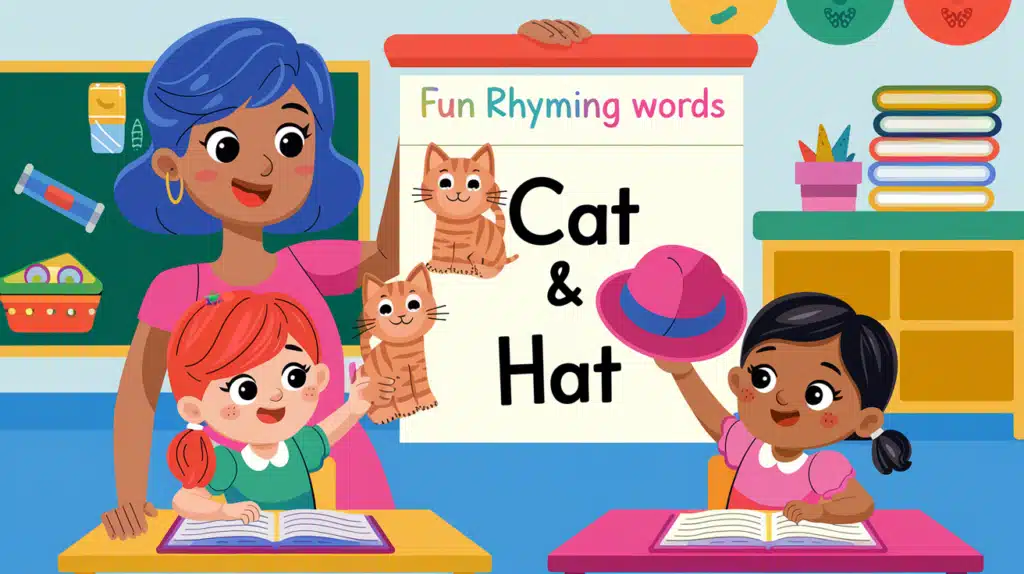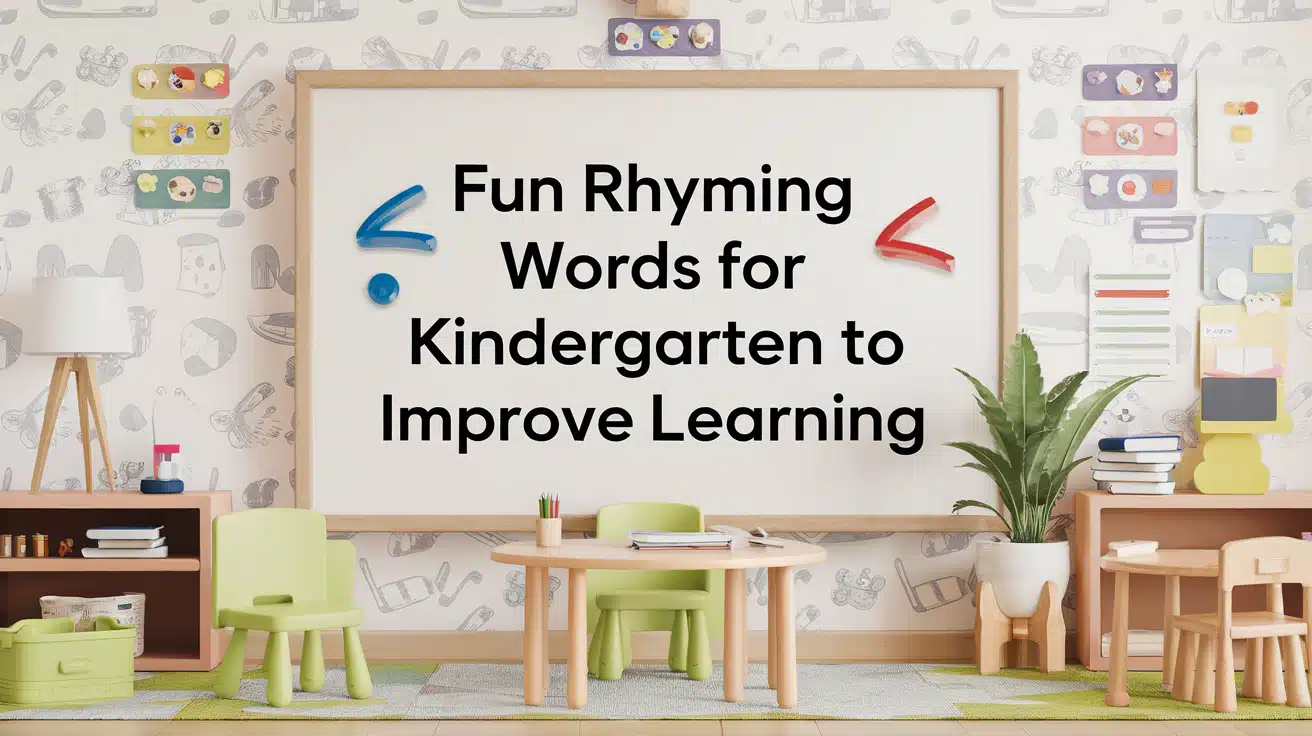Have you ever noticed how kids love to sing songs or repeat silly rhymes? Rhyming words are an essential part of early learning for young children, especially in kindergarten. They not only make learning fun but also help kids develop their language skills.
By recognizing patterns in words, children can better understand how sounds work together, which is a crucial step in reading and writing.
In this blog, we will explore some easy rhyming words for kindergarten students and why they’re important. These fun and simple words can be a great way to boost your child’s confidence in learning.
What are Rhyming Words?
Rhyming words are words that sound alike at the end. For example, “bat” and “hat,” or “dog” and “log.” These words have similar ending sounds, even if they start with different letters.
Rhyming helps kids understand how words can be connected through sounds. It makes it easier for them to learn new words and recognize patterns in language.
When children practice rhyming, they start to hear the differences and similarities between sounds, which helps with reading and writing.
Rhyming Words for Kindergarten

Rhyming words are important for young kids. They help kindergarteners understand how words work and make it easier for them to read and write. Here are some easy rhyming words for children to start with.
| # | Words That Rhyme With | Rhyming Word 1 | Rhyming Word 2 |
|---|---|---|---|
| 1 | Cat | Hat | Bat |
| 2 | Sun | Fun | Run |
| 3 | Dog | Log | Frog |
| 4 | Bed | Red | Led |
| 5 | Man | Can | Fan |
| 6 | Pen | Ten | Hen |
| 7 | Mud | Bud | Stud |
| 8 | Sit | Hit | Kit |
| 9 | Tag | Bag | Rag |
| 10 | Duck | Truck | Luck |
| 11 | Chin | Pin | Win |
| 12 | Goat | Boat | Float |
| 13 | Fat | Cat | Hat |
| 14 | Pin | Tin | Bin |
| 15 | Tear | Bear | Care |
| 16 | Pat | Hat | Bat |
| 17 | Pit | Sit | Hit |
| 18 | Pie | Sky | Lie |
| 19 | Red | Bed | Shed |
| 20 | Bug | Jug | Rug |
| 21 | Sing | Ring | King |
| 22 | King | Wing | Thing |
| 23 | Bell | Sell | Well |
| 24 | Bone | Cone | Stone |
| 25 | Cloud | Loud | Proud |
| 26 | Door | Floor | More |
| 27 | Cup | Sup | Up |
| 28 | Ant | Plant | Grant |
| 29 | Play | Day | Bay |
| 30 | Ring | King | Sing |
| 31 | Star | Car | Bar |
| 32 | Night | Light | Bright |
| 33 | Heart | Part | Start |
| 34 | Rain | Train | Pain |
| 35 | Shine | Line | Mine |
| 36 | Home | Roam | Foam |
| 37 | Breeze | Freeze | Seas |
| 38 | Sky | Fly | My |
| 39 | Jump | Bump | Lump |
| 40 | Pie | Sky | High |
| 41 | Rock | Sock | Clock |
| 42 | Bear | Chair | Fair |
| 43 | Rain | Train | Brain |
| 44 | Hat | Bat | Mat |
| 45 | Fun | Sun | Bun |
| 46 | Lid | Kid | Grid |
| 47 | Cot | Pot | Hot |
| 48 | Hill | Fill | Spill |
| 49 | Boat | Coat | Throat |
| 50 | Shout | Doubt | Pout |
| 51 | Light | Fight | Sight |
| 52 | Play | Sway | Gray |
| 53 | Rock | Dock | Mock |
| 54 | Flame | Game | Same |
| 55 | Look | Book | Took |
When kids practice rhyming words, they can improve their ability to listen to sounds and remember words. It’s a fun way to help them learn and feel more confident with reading and writing.
Why Rhyming Matters
Rhyming is important because it helps children recognize and remember sounds. When kids hear words that rhyme, they start to notice how letters and sounds work together. This is one of the first steps in learning to read and write.
Understanding rhyming words makes it easier for them to figure out new words when they begin reading stories and books.
It also gives them a head start with spelling, as they become familiar with common patterns in words. When children match sounds, they are more likely to spell words correctly.
Not only does rhyming make learning fun, but it also helps improve important skills like listening and memory.
As children practice rhymes, they learn to pay attention to the sounds they hear, which strengthens their listening abilities.
Repeating rhyming words also boosts their memory, helping them remember new words and phrases more easily.
Plus, rhyming activities are a great way to encourage creativity. Children enjoy making up their own rhymes, which helps them think in new ways and increases their confidence in using language.
Fun Rhyming Activities for Kindergarten
Engaging kindergarteners in rhyming through interactive games, music, and crafts helps strengthen their language skills while keeping them excited about learning. Here are some fun activities to try with your little ones
1. Rhyming Word Matching Cards
Create a set of cards with pairs of rhyming words. Lay them face down, and have children take turns flipping two cards at a time to find matching pairs. This activity helps with memory and sound recognition.
2. Rhyming Scavenger Hunt
Hide objects or picture cards around the room that rhyme with each other. For example, hide a “hat” and a “cat.” Give the kids clues to find matching rhymes, making it a fun and active way to learn.
3. Rhyming Word Songs
Incorporate rhymes into songs children already know, like “Twinkle, Twinkle Little Star” or “Old MacDonald.” Changing up the words while keeping the tune will help kids connect sounds and rhythms to rhyming patterns.
4. Crafts with Rhyming Words
Use craft time to reinforce rhyming. For example, create a “hat” from construction paper and decorate it with images of things that rhyme, like a “cat” and a “bat.”
5. Rhyming Word Puzzles
Design simple puzzles with rhyming words on them. Have children match the pieces together based on the rhyming sound, reinforcing word recognition in a playful way.
These activities make learning rhymes fun and interactive, helping children develop important literacy skills.
Conclusion
In this blog, we’ve seen how important rhyming words are for kindergarten in helping young learners develop their reading and writing skills.
By recognizing and practicing rhymes, children improve their ability to hear sounds, remember words, and spell correctly. These fun activities make learning enjoyable and interactive, encouraging kids to be more confident in their literacy journey.
Now, it’s your turn! Try out some of these rhyming activities at home or in the classroom, and don’t forget to share your own favorite rhyming word lists with others.
Keep searching for more fun ways to increase early learning by checking out our other blogs!




